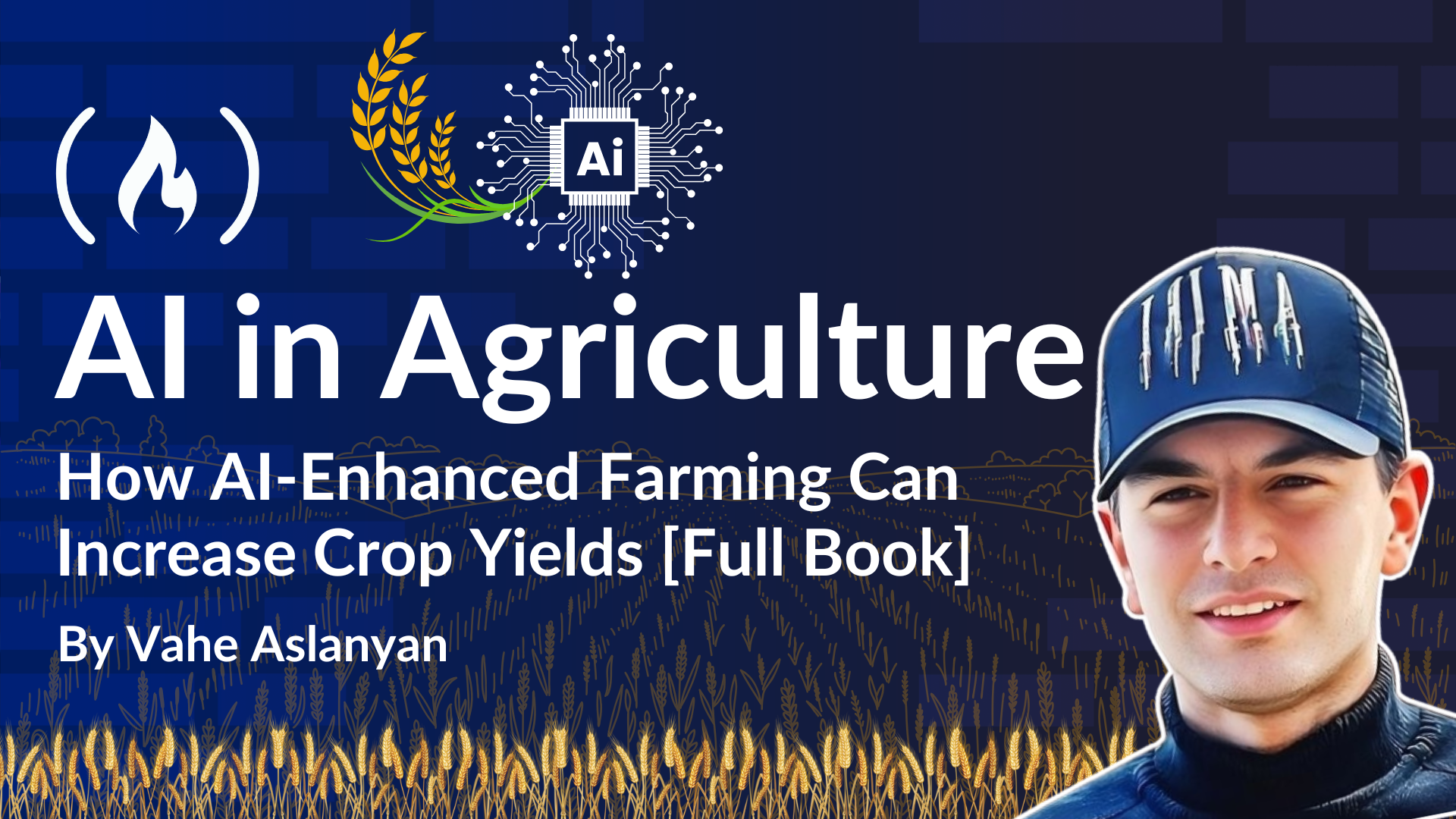
Chapter 5: How to Leverage Big Data and Computer Vision in Farming
Chapter 5: How to Leverage Big Data and Computer Vision in Farming 관련
As we explore how AI can help improve agricultural practices, we need to explore the nuances of how big data and computer vision technologies play crucial roles in achieving such ambitious goals.
This chapter will give you a comprehensive overview of the transformative impact that these technologies have on modern agriculture, offering detailed insights and practical examples that highlight their significance and implementation.
The Role of Big Data in Precision Agriculture
Big data analytics is a cornerstone of precision agriculture, where the primary aim is to monitor and manage field variability more effectively.
Farmers collect vast amounts of data through sensors, drones, and satellite imagery, encompassing soil conditions, weather patterns, and crop health. This data is then analyzed to elucidate trends and patterns that inform decision-making.
For instance, understanding soil moisture levels can help optimize irrigation schedules, while tracking weather conditions enables better planning for planting and harvesting.
The predictive power of big data can also guide the application of fertilizers and pesticides, ensuring they are used only when necessary and in precisely the right amounts. This not only saves costs but also minimizes the environmental impact of agricultural practices, addressing the pressing issues of sustainability and resource conservation.
Enhancing Crop Monitoring with Computer Vision
Computer vision technologies significantly enhance crop monitoring by providing high-resolution, real-time images of fields. Drones equipped with multispectral and hyperspectral cameras can fly over large areas, capturing detailed images that reveal information invisible to the naked eye—a critical advantage for early detection of stress factors such as pests, diseases, and nutrient deficiencies.
For instance, a farmer can use drone imagery to identify sections of a field suffering from water stress. By pinpointing these areas precisely, irrigation can be targeted and regulated accordingly, avoiding over-watering or under-watering, which can detrimentally affect crop yield.
Similarly, early detection of pest infestation through computer vision allows for timely intervention, mitigating damage and potential yield loss.
AI Models for Predicting Crop Yields
AI-powered predictive analytics are revolutionizing the way farmers forecast crop yields. By integrating various data sources, including current and historical soil quality data, weather patterns, and crop health metrics, AI models generate accurate yield predictions. These models use machine learning algorithms to continuously improve their accuracy as they are exposed to more data.
For example, if historical data indicates that a particular crop yield decreases under specific weather conditions, the AI model can predict similar outcomes and recommend proactive measures. This might include adjusting planting dates, choosing drought-resistant crop varieties, or optimizing irrigation schedules.
Such insights empower farmers to make informed decisions that enhance productivity and reduce risks associated with unforeseen variables.
Empowering Farm Management with Data-Driven Insights
Farm management software integrated with big data analytics and AI provides a holistic view of farm operations. These platforms consolidate data on everything from soil moisture levels to fertilizer usage, making it easier for farmers to plan and execute their activities efficiently. By offering real-time insights and recommendations, these tools help in optimizing resource allocation, thus enhancing productivity and sustainability.
Consider a scenario where a farmer uses farm management software to track the efficiency of different watering systems. The software can analyze data from various sections of the farm, revealing which system operates most efficiently under different conditions. This allows the farmer to make data-driven decisions on where to invest in irrigation infrastructure, thereby improving water use efficiency and reducing costs.
Sustainable Farming Practices Through Data Integration
Integrating data from multiple sources not only optimizes individual farming practices but also promotes overall sustainability. By combining data on soil health, weather patterns, and crop performance, farmers can adopt practices that improve soil fertility, reduce chemical inputs, and conserve water. For instance, data-driven crop rotation schedules can enhance soil health and reduce pest and disease pressure, consequently lowering reliance on synthetic fertilizers and pesticides.
Additionally, big data and computer vision can support the adoption of precision irrigation and fertigation techniques. For example, data on soil moisture levels and plant growth stages can be used to apply water and nutrients precisely when and where they are needed, reducing waste and environmental impact. This aligns with broader goals of sustainability and resource conservation, ensuring that agricultural practices remain viable and productive in the face of climate change and a growing global population.
Code Examples
Below are three examples that demonstrate how LLM applications can be integrated into AI-enhanced farming to increase crop yields by up to 70% by 2030. These examples showcase how LLMs can be used to analyze big data, interpret computer vision inputs, and generate predictive analytics for decision-making.
Example 1: Big data in precision agriculture for irrigation and fertilization
Objective: Use an LLM to analyze data from sensors, satellite imagery, and weather forecasts. Based on the analysis, the LLM generates an optimal irrigation and fertilization schedule.
import openai
# Sample big data inputs: weather forecasts, soil sensors, and satellite imagery
big_data = {
"weather_forecast": {
"today": {"temp": 28, "humidity": 50, "precipitation": 10},
"next_week": [
{"day": "Monday", "temp": 30, "precipitation": 5},
{"day": "Tuesday", "temp": 32, "precipitation": 0}
]
},
"soil_conditions": {
"moisture_level": 35, # in percentage
"nutrient_levels": {"nitrogen": 40, "phosphorus": 20, "potassium": 30} # ppm
},
"satellite_imagery": {
"crop_health_index": 0.8, # normalized index (0 to 1)
"vegetation_density": "moderate"
}
}
# Generate a description for the LLM
big_data_description = (
f"The weather forecast indicates a temperature of {big_data['weather_forecast']['today']['temp']}°C "
f"with 50% humidity and 10mm of precipitation today. Soil moisture is at {big_data['soil_conditions']['moisture_level']}%. "
f"Nutrient levels are: nitrogen at {big_data['soil_conditions']['nutrient_levels']['nitrogen']} ppm, phosphorus at "
f"{big_data['soil_conditions']['nutrient_levels']['phosphorus']} ppm, and potassium at {big_data['soil_conditions']['nutrient_levels']['potassium']} ppm. "
f"The crop health index from satellite imagery is 0.8, indicating moderate vegetation density."
)
# Use LLM to generate optimal irrigation and fertilization recommendations
response = openai.ChatCompletion.create(
model="gpt-4",
messages=[
{"role": "system", "content": "You are an AI agricultural assistant specializing in big data analysis for irrigation and fertilization."},
{"role": "user", "content": f"Based on the following big data, provide irrigation and fertilization recommendations: {big_data_description}"}
]
)
recommendations = response.choices[0].message['content']
print(recommendations)
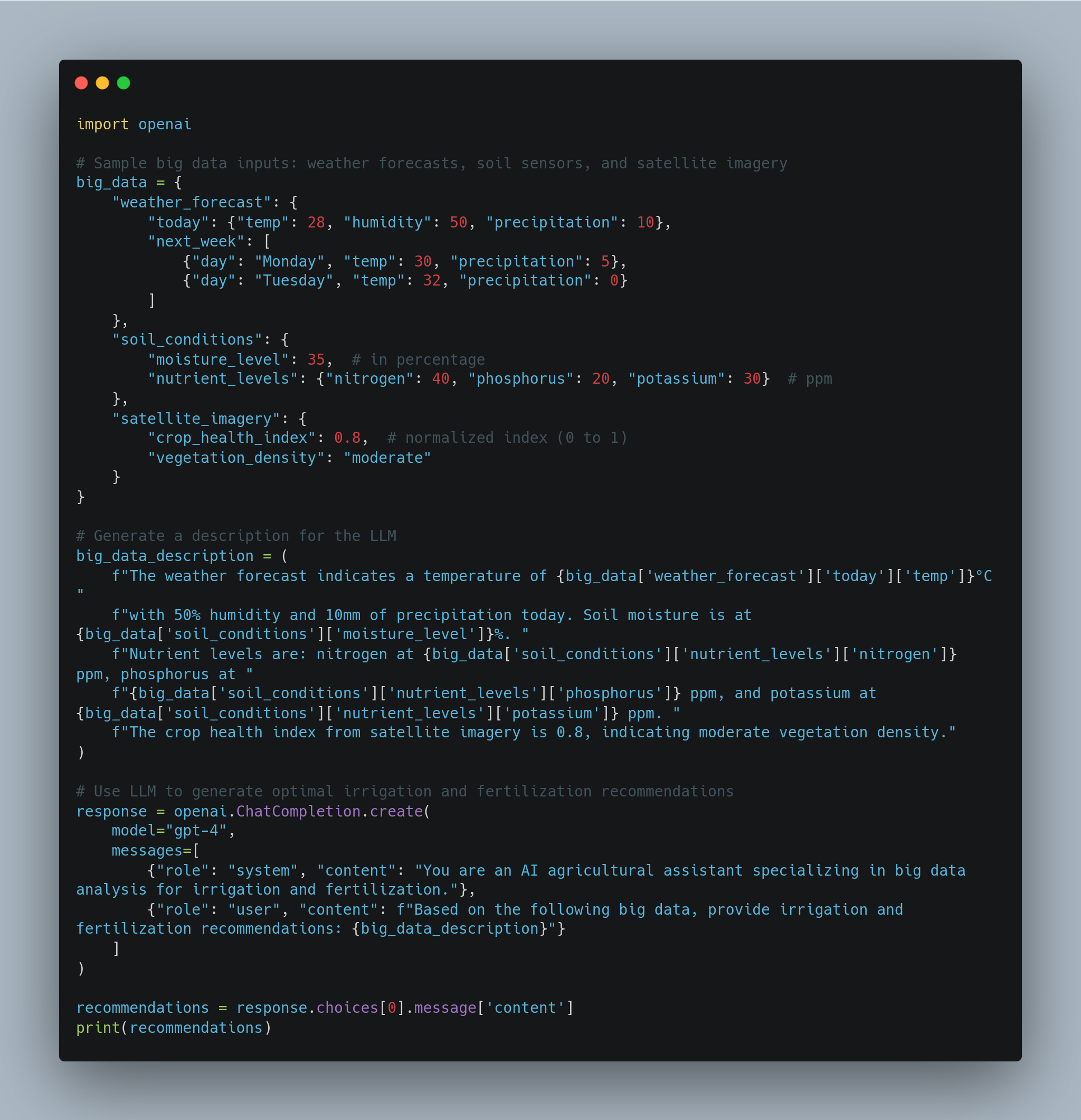
lunartech.ai
**Irrigation Recommendations:**
Given the current soil moisture level of 35%, and the precipitation forecast of 10mm today, additional irrigation is not required today. However, as the temperature rises to 30-32°C next week, plan for irrigation on Tuesday, especially if soil moisture drops below 30%.
**Fertilization Recommendations:**
- Nitrogen levels are at 40 ppm, which is slightly below the optimal range for active growth phases. Apply nitrogen-rich fertilizer at 25% of the recommended dose over the next two days.
- Phosphorus levels are low at 20 ppm. Apply phosphorus-rich fertilizer at 50% of the standard rate to improve root development.
- Potassium levels are adequate but can be boosted with a light application to support flowering and fruiting.
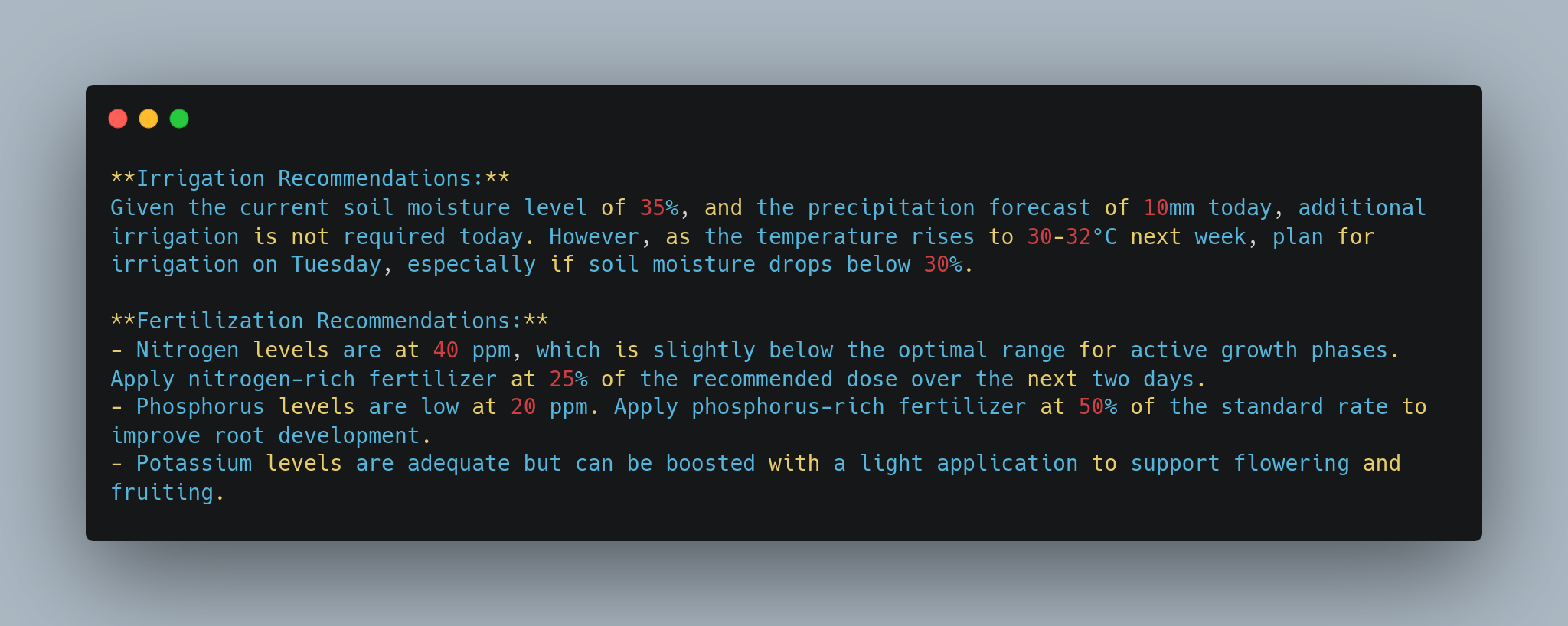 ](https://lunartech.ai)
](https://lunartech.ai)
Example 2: Computer vision for detecting crop diseases and nutrient deficiencies
Objective: Integrate computer vision data from drones into an LLM to analyze crop health and generate early disease detection and nutrient deficiency recommendations.
import openai
# Sample data from drone-based computer vision system
vision_data = {
"field_images": {
"zones": {
"Zone_1": {"water_stress": "none", "nutrient_deficiency": "low nitrogen", "disease_spots": "none"},
"Zone_2": {"water_stress": "moderate", "nutrient_deficiency": "none", "disease_spots": "possible fungal infection"}
}
},
"crop_health_metrics": {
"average_growth_rate": "good",
"vegetation_health_index": 0.85, # 0 to 1 scale
"detected_pests": "none"
}
}
# Generate a description for the LLM based on vision data
vision_data_description = (
f"Zone 1 has no water stress, but low nitrogen deficiency is detected, with no disease spots. "
f"Zone 2 has moderate water stress, no nutrient deficiencies, but possible fungal infection spots were detected. "
f"Average growth rate is good, with a vegetation health index of 0.85, and no pests detected."
)
# Use LLM to generate recommendations based on computer vision analysis
response = openai.ChatCompletion.create(
model="gpt-4",
messages=[
{"role": "system", "content": "You are an expert in agricultural disease management and nutrient analysis."},
{"role": "user", "content": f"Based on the following computer vision data, provide recommendations for nutrient deficiency and disease management: {vision_data_description}"}
]
)
crop_health_recommendations = response.choices[0].message['content']
print(crop_health_recommendations)
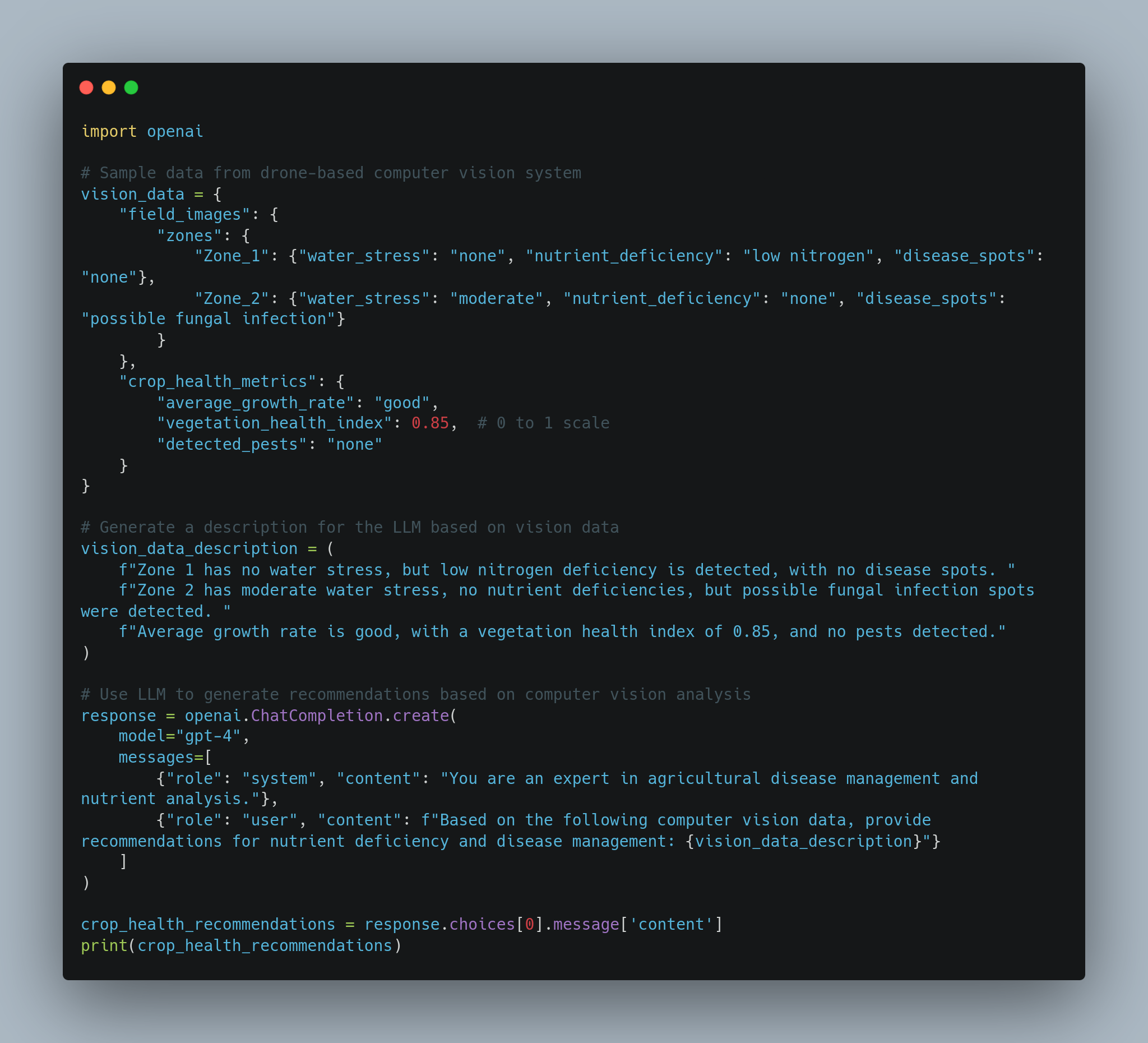
lunartech.ai
**Zone 1 Recommendations:**
- Address the low nitrogen deficiency by applying nitrogen-rich fertilizer, such as urea, at a rate of 30% of the recommended dose. Monitor crop growth over the next week for improvement.
**Zone 2 Recommendations:**
- The moderate water stress should be alleviated by implementing targeted irrigation immediately. Focus on ensuring consistent soil moisture levels to reduce plant stress.
- The possible fungal infection should be treated with an appropriate fungicide. Apply a broad-spectrum fungicide as a preventative measure, and closely monitor the affected areas for further spread.
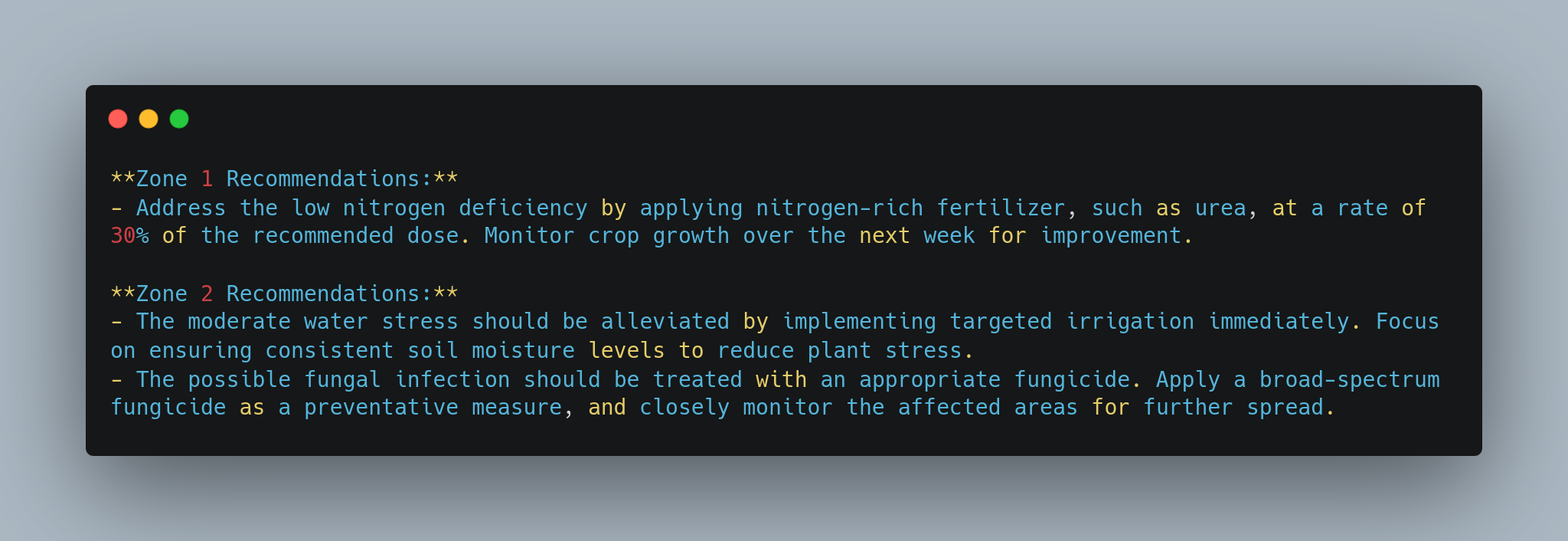 ](https://lunartech.ai)
](https://lunartech.ai)
Example 3: Predictive analytics for crop yield forecasting
Objective: Use LLMs to process historical data and predictive models to estimate crop yields based on real-time weather patterns and soil conditions.
import openai
# Sample historical and real-time data for predictive analytics
historical_data = {
"crop_type": "corn",
"historical_yield_per_hectare": 5000, # kg/ha
"historical_weather_patterns": {
"optimal_temp_range": [25, 30], # °C
"optimal_precipitation": 100 # mm/month
}
}
real_time_data = {
"current_temp": 28, # °C
"current_precipitation": 90, # mm this month
"soil_moisture": 50 # percentage
}
# Generate a description of the data for the LLM
data_description = (
f"The crop is corn, with a historical average yield of 5000 kg/hectare. The optimal temperature range for growth is between "
f"{historical_data['historical_weather_patterns']['optimal_temp_range'][0]}°C and "
f"{historical_data['historical_weather_patterns']['optimal_temp_range'][1]}°C, and optimal precipitation is 100 mm per month. "
f"Current conditions show a temperature of {real_time_data['current_temp']}°C, precipitation of {real_time_data['current_precipitation']} mm, "
f"and soil moisture at {real_time_data['soil_moisture']}%."
)
# Use LLM to generate a crop yield forecast based on this data
response = openai.ChatCompletion.create(
model="gpt-4",
messages=[
{"role": "system", "content": "You are an expert in crop yield forecasting using predictive analytics."},
{"role": "user", "content": f"Based on the following data, provide an estimated crop yield and suggestions for improving yield potential: {data_description}"}
]
)
yield_forecast = response.choices[0].message['content']
print(yield_forecast)
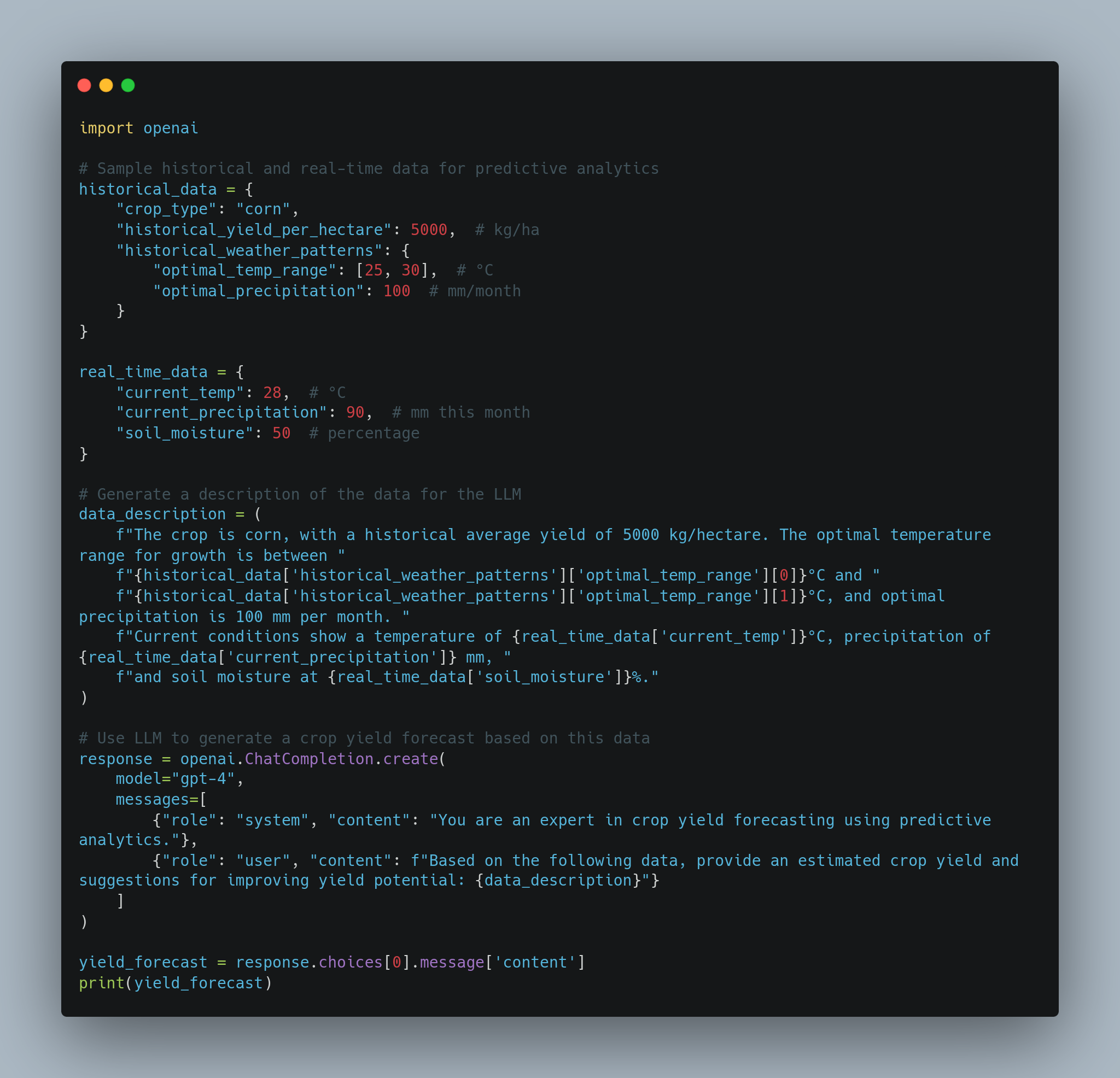
lunartech.ai
**Crop Yield Forecast:**
Given the current temperature of 28°C, which falls within the optimal range for corn growth (25-30°C), and a slightly lower-than-optimal precipitation level of 90 mm (optimal is 100 mm), the crop yield is projected to be around 4800 kg/hectare. The current soil moisture level of 50% supports healthy growth.
**Suggestions for Improving Yield:**
- To maximize yield potential, consider increasing irrigation to make up for the slightly lower precipitation levels this month. Aim to maintain soil moisture at 60-70% to support optimal growth during the reproductive phase of the corn crop.
- Regular monitoring of soil moisture and weather conditions is crucial to adjust irrigation and nutrient inputs dynamically throughout the season.
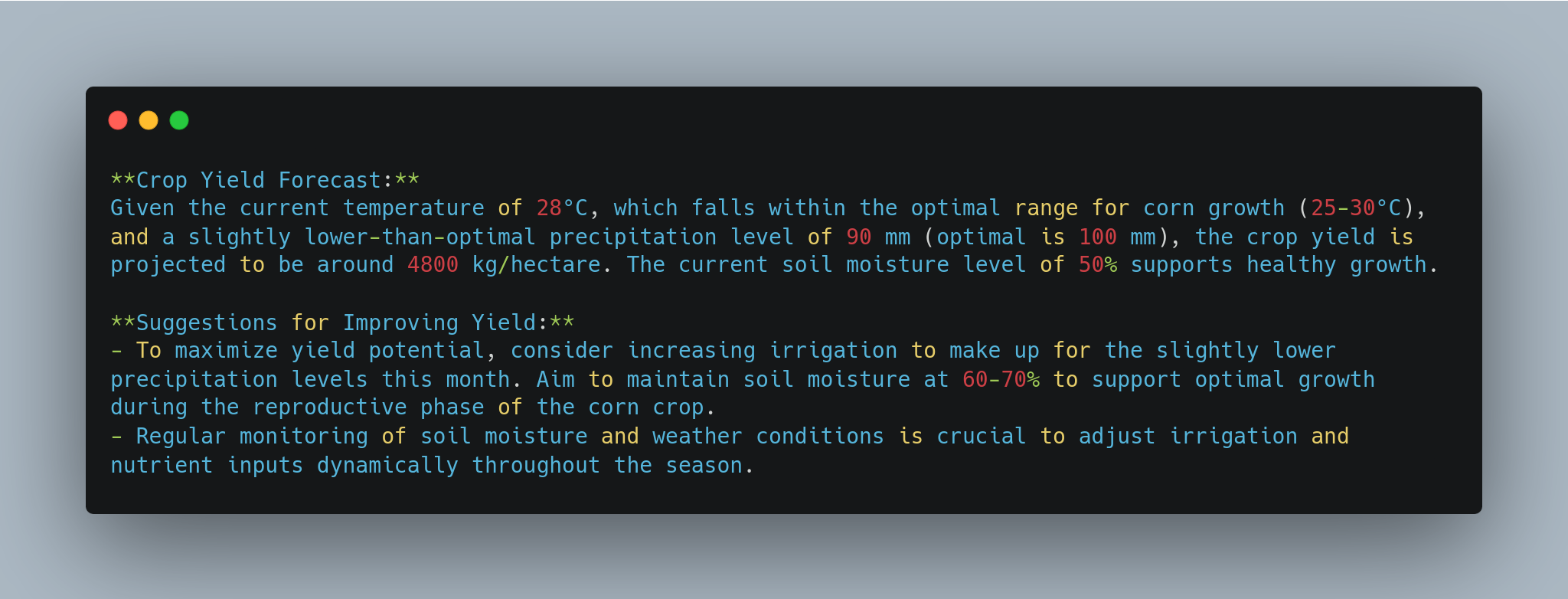
lunartech.ai
In Example 1, we used LLMs to analyze large datasets from sensors, satellite imagery, and weather forecasts to provide irrigation and fertilization schedules, ensuring that crops receive the right amount of water and nutrients.
In Example 2, you learned how LLMs can interpret data from drone-based computer vision systems to detect signs of water stress, nutrient deficiencies, and potential diseases. The model generates targeted interventions to improve crop health.
And in Example 3, we used LLMs to process historical and real-time data to forecast crop yields and recommend adjustments to optimize yield, such as increasing irrigation or adjusting nutrient levels based on environmental factors.
In all three examples, LLMs helped process complex data and provide actionable insights for farmers, supporting decisions that improve crop yields, sustainability, and resource efficiency.
The integration of big data and computer vision technologies is undeniably transforming agriculture, making it more efficient, sustainable, and resilient. By leveraging these advanced tools, farmers are better equipped to navigate the complexities of modern farming, addressing challenges such as climate variability, resource limitations, and the need for increased productivity.